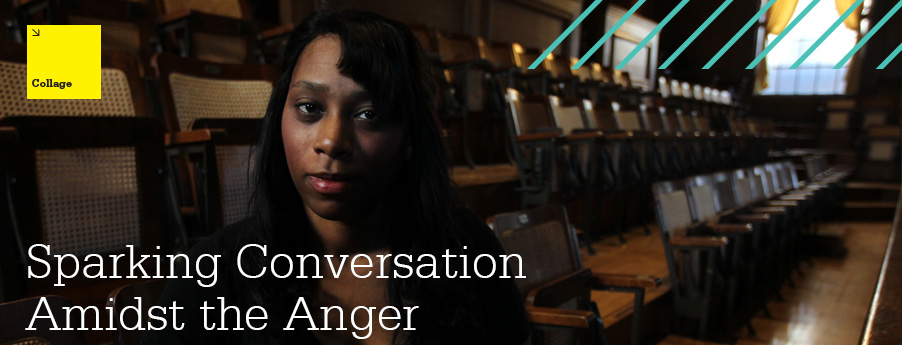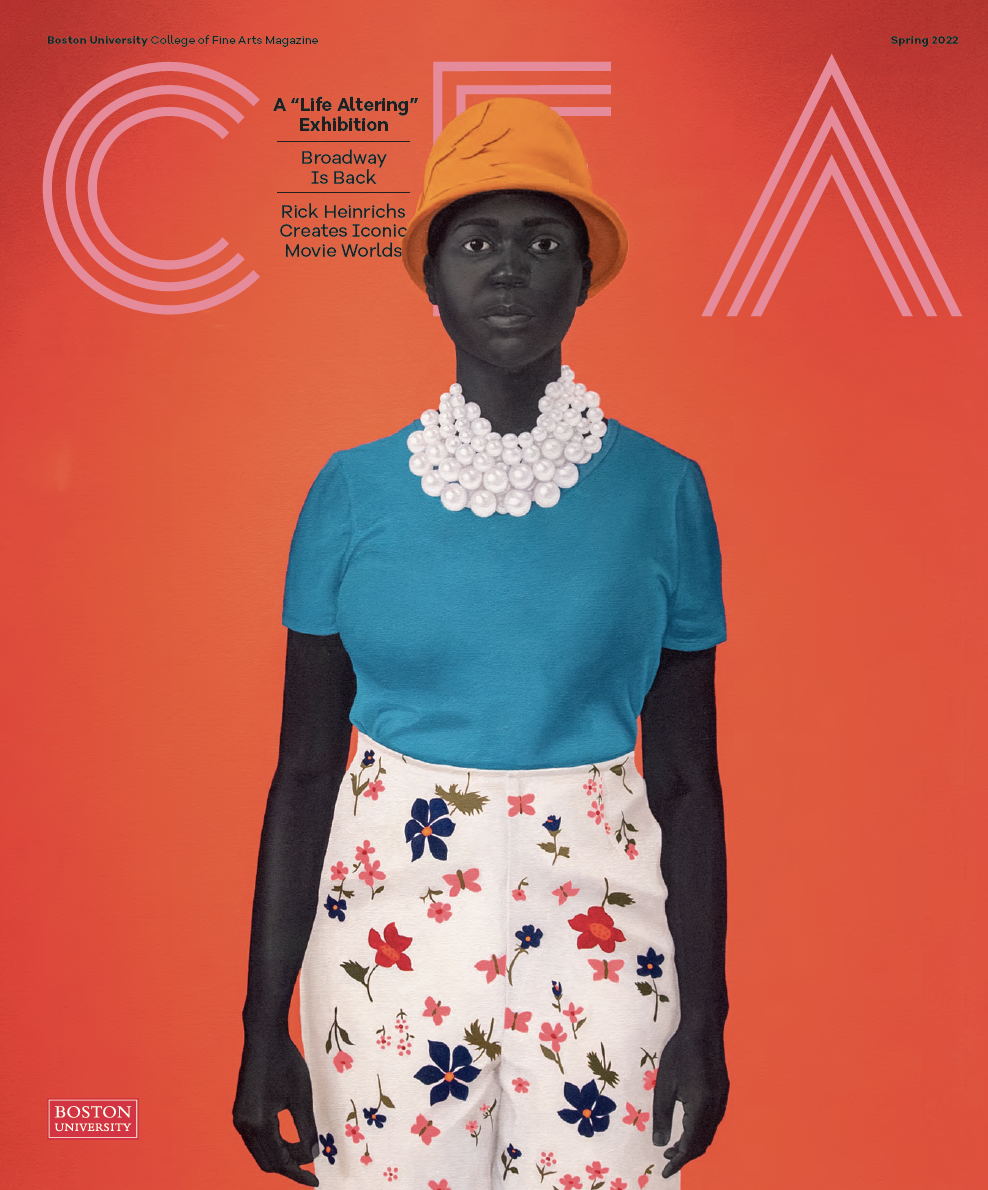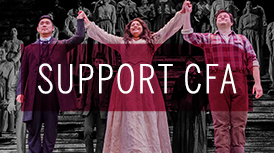Sparking Conversation Amidst the Anger
By Adrienne Boris
Banner image: Kirsten Greenidge, an assistant professor of playwriting and theatre arts at CFA, tackles issues of race and class in her play Baltimore, which premiered at BU. Photo by Bill Greene/Boston Globe/Getty Images
A college resident assistant navigates a racial incident in Baltimore, a play by Kirsten Greenidge, an assistant professor of playwriting and theatre arts at CFA. Commissioned by the Big Ten Theatre Consortium’s New Play Initiative for female playwrights, Baltimore premiered at BU in a coproduction with New Repertory Theater and traveled to universities throughout the country in 2016. Adrienne Boris (’15), who directed the touring production, spoke with Greenidge about her provocative and timely drama.
Adrienne Boris: Baltimore deals with issues of race and class on a national and on a more intimate scale. What draws you to these kinds of stories?
Kirsten Greenidge: I’m drawn to stories that are historical, which comes from my mission as a playwright, which has always been, since I was 11 or 12 years old, to write stories for people who don’t see themselves on stage very often, and to write roles for actors who don’t always have roles built for themselves on stage. So, I’m constantly looking for stories and roles that female actors of color, in particular, would want to play.
The Big Ten Theatre Consortium is made up of the theater department heads at 10 universities throughout the country. Their New Play Initiative is dedicated to commissioning, producing, and publicizing new plays by American female playwrights that feature strong, age-appropriate roles for women, particularly female artists of color. So it must have been exciting when they approached you?
Yes! I remember getting a phone call from Alan MacVey—I know Alan because he is [a professor and chair of the Theatre Arts Department, and the director of the Division of Performing Arts] at the University of Iowa where I went to grad school. I also learned that [playwright] Naomi Iizuka had begun the first commission, and Naomi was a teacher and mentor of mine at Iowa.
In addition to all that, I knew it was a project I was interested in because its mission is so close to my own as an artist: to create opportunities for female artists and female artists of color.

Jade’ Davis (’16) (front) and Linda Vanessa Perla (’18) (back, from left), Desiré Hinkson (’18), Ami Park (’16), Lexi Jenne (’18), and Kalei Devilly (’18) star in Baltimore. Photo by Kalman Zabarsky
What inspired you to write Baltimore?
Alan MacVey told me a story that had happened to him when he was a resident advisor at Stanford, and I was captivated by it. It struck me as universal because it was a story about a young person who really wanted to do well, but by his own admission, didn’t have the resources to do so. So that was really the jumping-off point for the situation the young protagonist of Baltimore finds herself in.
I was also very interested in how information spreads, through the internet especially, and how to have people talk about a very difficult topic without needing to have solutions. If this play could offer a solution to America’s racial woes then, “Yay!”—we’d spread it all over the place, and we wouldn’t have a problem anymore. But, I think it would be a false hour and a half in the theater if the play were to pretend to be able to do that.
So how do we make the piece worthwhile without offering solutions? How do we get as many voices heard as possible without the play feeling disingenuous and didactic? There’s no intermission for a reason, so we just plow right through this language, this verbiage about the students’ feelings about race, and about the incident.
Boston University, Boston Center for American Performance, and New Repertory Theatre collaborated in a rolling world premiere of Baltimore at universities throughout the country. Can you describe the process of writing the play with development processes in different communities? Did the workshop process at the BU School of Theatre and the University of Maryland Department of Theatre and Dance influence your writing?
Definitely. At the University of Maryland, we had a workshop in May 2015, right after the riots in Baltimore. That was extremely valuable and emotionally difficult. The students were so generous and opened up to me, a complete stranger. They told me really personal things they had not told their advisors or their families, things that are really hard to talk about and that ultimately ended up in the play.
I found that students were eager to understand each other’s stories and were also eager to play roles they didn’t usually get to play on stage—racially charged, contemporary roles that reflected their experience and were age-appropriate. So, for example, for an 18-year-old Asian American student, playing a contemporary Asian American student in Baltimore, versus playing a maid in a classical play, felt drastically different. I think both are valuable experiences, but these students had never gotten to experience the contemporary side.
In the summer, I began working closely with Elaine Vaan Hogue, [program head of Theatre Arts and assistant professor of acting and directing] at Boston University. We scheduled two workshops and cast the reading from whoever was in the room. It was really exciting because there were a lot of people at both of those readings, and I got a lot of great feedback from so many of our students.
Elaine put it really well when she said the play verges on the “un-PC.” It has moments that make us say, “Oh dear. Should we really talk about race like that?” Some of those moments owe themselves to the University of Maryland workshop.
You wrote Baltimore at a pivotal time in American politics, amidst police shootings, the Black Lives Matter movement, and the race riots in Baltimore, among other incidents. How did current events help shape the story?
One of the things that was so difficult about the workshop process at University of Maryland was that it was so soon after the riots. The students expressed what they felt was a reluctance to talk about race in class. One student mentioned trying to bring it up in a history class and being told it was not appropriate. Again and again these students were told, “Don’t bring it up in class, we don’t want to talk about it.”
“I truly believe that in the midst of all the anger (and there should be anger) and sadness, there is also room for actual conversation.”—Kirsten Greenidge
This was the first time I was speaking about race in this play with a generation of students who did not grow up right after the Civil Rights movement. Generally, they felt that some of the tools that had been used for Civil Rights in the 1950s and 1960s weren’t applicable today. Or, the job hadn’t been done; so, “What now?”
What kinds of discussions do you hope the play will spark?
I hope it will spark productive conversations about race. I’ve noticed two prevailing responses to racial issues in America: There’s of course the anger, the vitriol about race, and then there are sentimental stories about negative things that have happened because of race discrimination that are almost untouchable. They can inspire action, but in the moment, as they are being told, the listener can really only feel anger or sadness about them. I truly believe that in the midst of all the anger (and there should be anger) and sadness, there is also room for actual conversation.
What do you think of Boston’s response to the issue of race and gender parity in the theater? What are we doing right and what is still to be done?
Of course I would like to see more roles for women and people of color. However, in particular, I think we need to look at the choices all theaters—not just the large and mid-size ones—make about what they put on their stages. When [gender parity watch-lists such as The Kilroys] come out, we tend to go after the biggies and hold them by the neck and say, “Look what you did!” But smaller theaters and community theaters also have a lot of responsibility. They are doing a lot of quality work, but when they produce a season of only male playwrights or employ only male directors or program plays that only have majority roles for male actors, that sends a message.
I think people are paying more attention to it, but it can always get better. I think it will also take a cultural shift in our appreciation for female directors, playwrights, theater artists, and female leaders in general. There is a lot of work out there, and not being able to find these artists should no longer be an excuse. At this point, it is not an accident when people don’t pay attention.
A version of this article originally appeared in the program for Baltimore.










